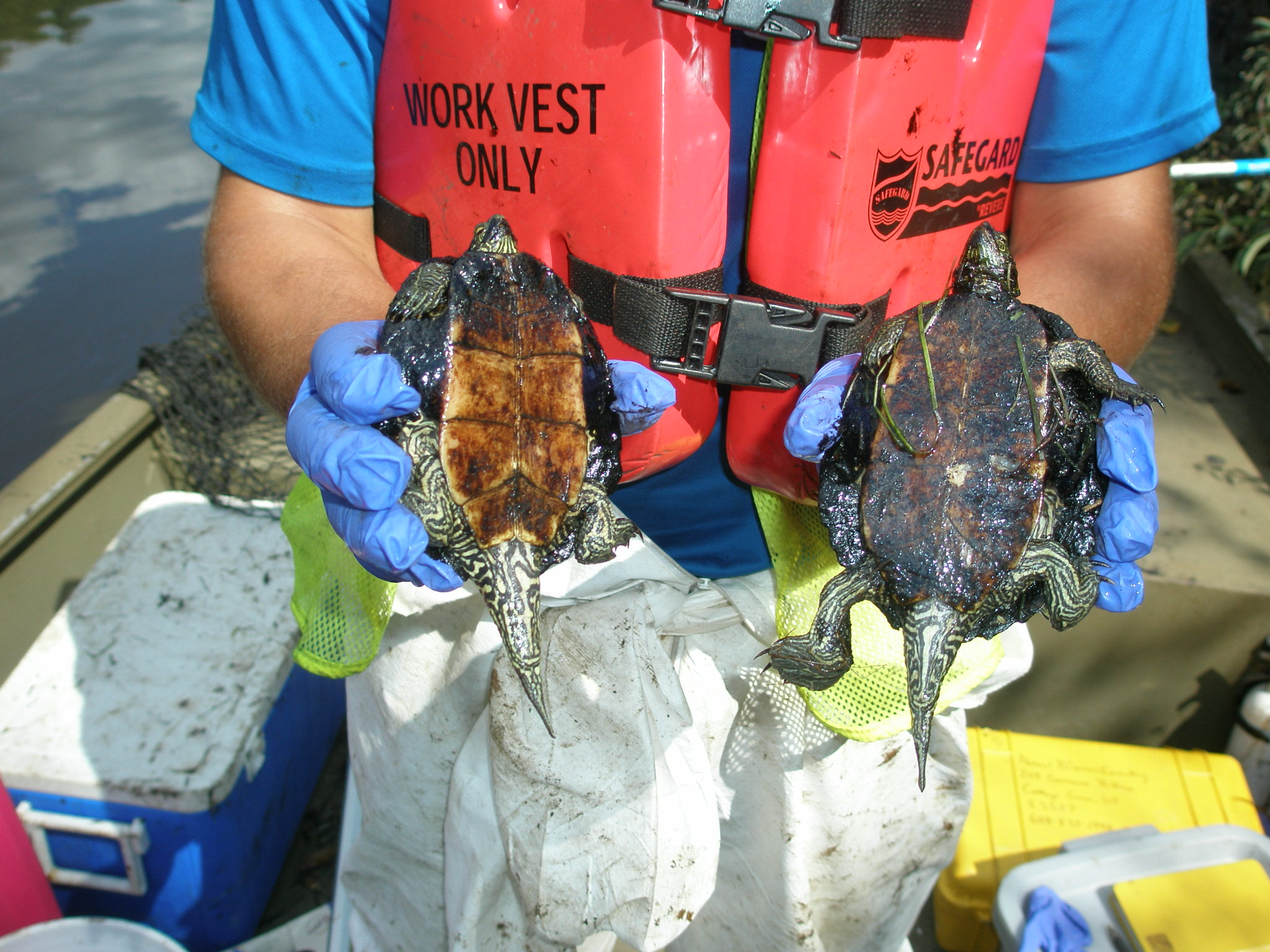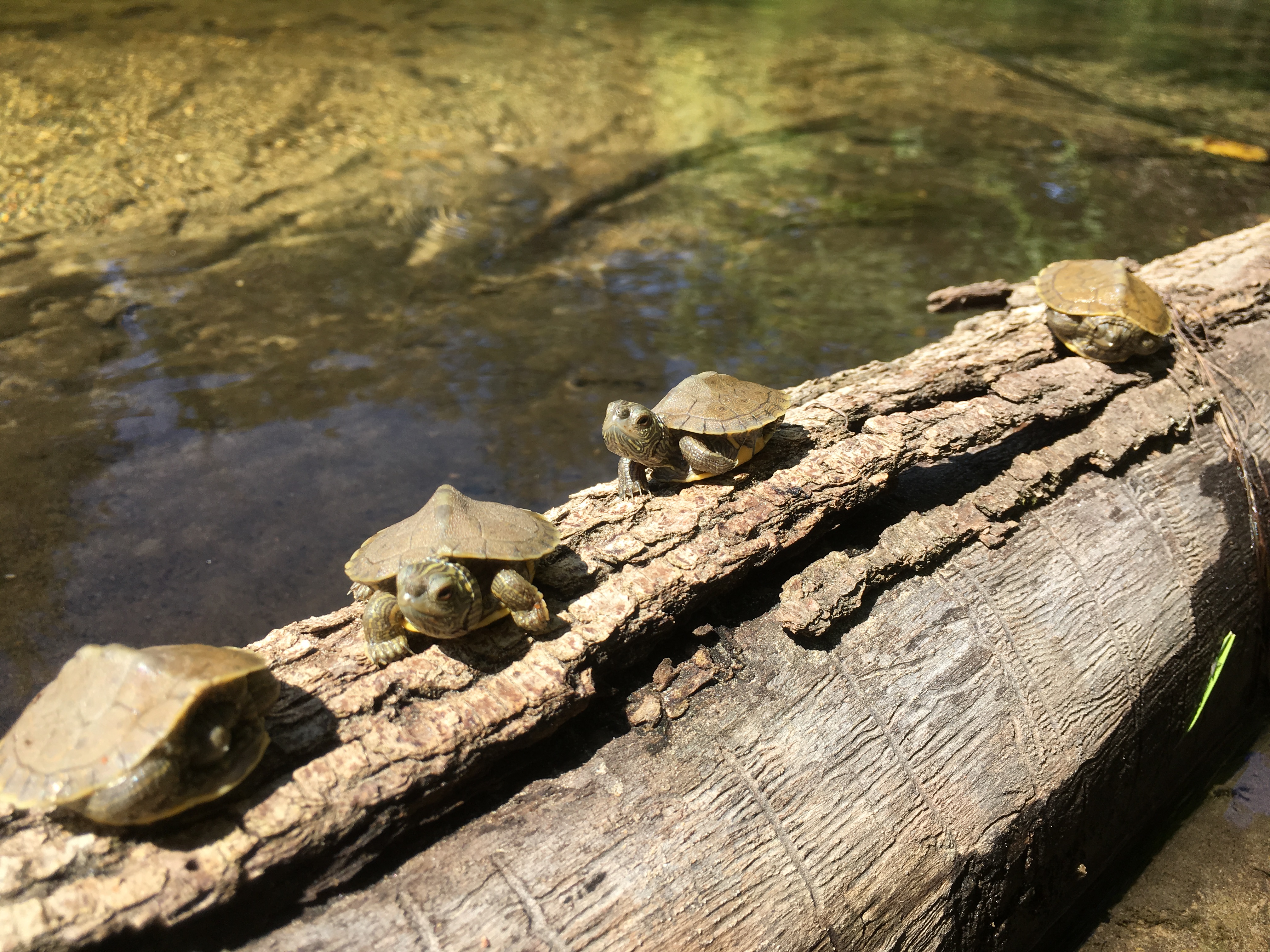
Josh Otten reached down and pulled two turtles from the bow compartment of his kayak. One was the size of a dinner plate; the other was barely the size of a silver dollar pancake. Both were northern map turtles, the most common species of turtle in the Kalamazoo River watershed, according to Otten who played a key role in the rescue and rehabilitation of more than 2,000 turtles in 2010 following the Kalamazoo River oil spill.
Otten held the tiny turtle gingerly between his thumb and finger. The hatchling was only a few weeks out of the nest, Otten said. He pointed to two small notches on the edge of the larger turtle’s shell. Otten filed the notches 10 years ago. That turtle was a spill survivor.
June and July of 2010 saw an unusually high amount of rain, causing the Kalamazoo River to overflow its banks. Floodwaters penetrated deep into the wetlands that border the river in a natural flooding that occurs annually.
During the night of July 25 to 26, 2010, a 50-year-old pipeline transporting oil near Talmadge Creek, a small tributary of the Kalamazoo River, ruptured. Within hours, the surface of the Kalamazoo River was covered in black oil. Calhoun County emergency lines blew up with calls from concerned residents. A terrible smell of gas was making people ill.
Michelle Barlond Smith and her family lived near the river. In an interview with the National Wildlife Federation, she said her young children became nauseous while she and her husband experienced severe headaches following the spill.
Oil from the ruptured pipe flowed into Talmadge Creek for 17 hours before Enbridge, the company that owns the pipeline, shut it down, according to a National Transportation Safety Board 2012 incident report.
The EPA determined that over 1.2 million gallons of tar-sand oil were released into Talmadge Creek and subsequently the Kalamazoo River.
Three months earlier, the Deep Horizon oil spill in the Gulf of Mexico illustrated the need for an immediate national response plan for large-scale oil spills. As part of the new plan, the EPA mobilized oil spill experts from across the country and directed them to Kalamazoo, Michigan.
Turtle Rescue
The Kalamazoo River is home to six species of turtle. Northern map turtles are the most common species. Snapping turtles are the largest species. Spiny softshell turtles are often called leatherbacks. There’s only a small number of painted turtles as they prefer ditches to rivers, with even fewer musk turtles, which can live 50 years. The rarest of the lot are Blanding’s turtles, a threatened species in Michigan.
Snapping and musk turtles spend most of their time on the river bottom only occasionally coming up for a breath of air, Otten said, while northern map and softshell turtles pop in and out of the water dozens of times throughout the day.
“We lucked out in that there was a large building in Marshall, Michigan, that was available,” Otten said. The space was transformed into a temporary wildlife rehab center. The center housed the animal-intake services, volunteer cleaning stations, a veterinarian field hospital including an ICU and hundreds of recovery tanks.
“Volunteers were required to take a minimum 4 hour training related to the spill and working with oil, then additional training for their wildlife-specific tasks,” Lisa Williams with the U.S. Fish and Wildlife Service explained via email. Wildlife-specific training included how to stay safe from scratches, bites and disease transmission.
When animals arrived at the rehab center, they were photographed and examined by vets. Following their examination, turtles were given a bubble bath in a child-sized swimming pool with a power-washer and lots of Dawn dishwashing detergent.
Then, every day, dozens of volunteers showed up to help clean turtles.
“I don’t know what we would have done without them,” Otten said.
Volunteers spent hours meticulously cleaning every wrinkle, crease and crevice on the turtles with toothbrushes and cotton swabs dipped in Dawn.

Kalamazoo River turtle (Photo courtesy of Chris Battaglia, Focus Wildlife)
To reduce stress on the turtles, cleanings were strictly limited to one-hour sessions. Otten said it often took several days to get one turtle completely clean.
“We got to the point where we were getting 100 new turtles a day,” he said.
In addition to shell and skin cleaning, many of the turtles’ mouths were filled with oil. They needed to be cleaned inside and out. Mayonnaise was used as a natural turtle stomach cleanser as it encouraged the oil to pass through their bodies quickly.
In addition to cleaning, Otten and the turtle rescue team in Kalamazoo faced several other challenges. The most pressing was what to do with the cleaned turtles. An animal rescued on day three of the spill might be ready for release by day seven. One week after the spill, restoration efforts were just ramping up with years of disruptive work anticipated.
Biologists from the U.S. Fish and Wildlife Service and Michigan Department of Natural Resources surveyed areas up and down the Kalamazoo River searching for habitats similar to the spill zone. Release locations were located at sites 30 kilometers upstream and 30 kilometers downstream, Otten said.
“Turtles have high site fidelity, meaning they know where home is and they want to get back there,” Otten said. The researchers hoped that by releasing the turtles in the same river they would eventually make their way home. And hopefully, by that time, the restoration work would be complete and it would be safe for the turtles to return.
Turtles hibernate on the river bottom. But little is known about when or how this process begins, Otten said. As a precaution, the rescue team decided to stop releasing turtles in late October. Five hundred turtles spent their winter in the wildlife rehabilitation center. All were released, along with some surprise hatchlings, in the spring of 2011.
Before release, each turtle was given an identifying mark – two notches on the right side, one notch on the left. Otten and the rescue team used a rasp file to create a permanent and pain-free ID system. This shellcode was used to create a database of the spill turtles’ history.
Oiled turtles continued to be found through the summer of 2011. In the fall of 2011, 16 months after the spill, the wildlife rehab center finally closed.
Altogether, approximately 2,500 turtles were rescued, rehabilitated and released.

Turtle hatchlings on the Kalamazoo River (Photo courtesy of Josh Otten)
Turtles Return
For years, Otten wondered if the thousands of hours of turtle rescue efforts had made a difference.
“You feel good about helping at the time,” he said. But the question of whether it had an impact lingered.
Seven years later, in 2018, Otten finally got his chance to find out when he began a study of turtles on the Kalamazoo River for his doctoral dissertation at the University of Toledo.
“I almost didn’t recognize it,” Otten said. Returning to the river, he saw almost no indication of the oil spill or the four years of intensive clean-up efforts that followed.
Otten is completing his second summer on the river. With two years of data ready for analysis, the scientist hesitated to draw early conclusions. But Otten saw some promising indicators.
Turtles released 30 kilometers up and downstream were back basking in the same areas as they were first found oiled. They survived and, more importantly, they found their way home.
Read more stories about animals and fish on Great Lakes Now:
Turtles vs. Oil: Great Lakes Now producer talks ecosystems, life on the water and covering the lakes
Offshore Decline: Great Lakes fish populations at risk from low nutrient levels
Dishwashing detergent killed hundreds of fish in Ohio river
Bald eagle shows air superiority, sends drone into lake
API key not valid. Please pass a valid API key.Featured image: Turtles from the Kalamazoo River (Photo courstey of Stantec Consulting Inc.)




